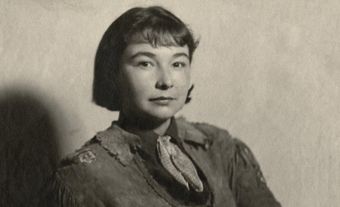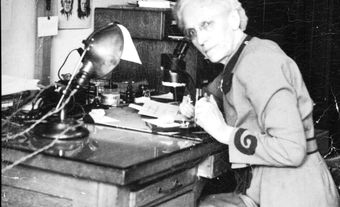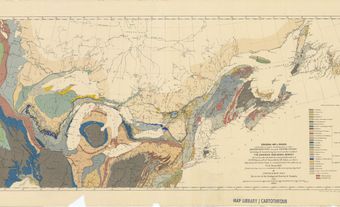Kathleen Creighton Starr Rice, homesteader, prospector (born 4 June or 22 December 1882 in St. Marys, ON; died 6 January 1963 in Minnedosa, MB). In addition to the women who prospected during the Klondike Gold Rush, Kathleen Rice is considered one of Canada’s first female prospectors. She staked claims in northern Manitoba, the most significant being her discovery of copper pyrite in 1928. She was also known as an outdoorswoman, frequently undertaking extensive solo trips by dogsled or in her canoe.

Early Life
Kathleen Rice was born to Henry Lincoln Rice and Charlotte Carter in St. Marys, Ontario. Her date of birth is inconsistently reported, but was likely 4 June or 22 December 1882. She had one younger brother, Lincoln. The Rices were affluent; her mother came from a successful milling family, and her father was a prominent businessman and public figure in St. Marys.

Rice’s father taught her how to canoe, set up a camp, shoot a rifle and read the stars, skills that proved useful later in life. She attended elementary and high school in St. Marys before the University of Toronto, where she received the Edward Blake Scholarship in classics and mathematics. During her time at university, Rice was involved in the YWCA and the Women’s Literary Society. She graduated with a Bachelor of Arts in 1906, with a specialization in mathematics.
After graduation, Rice taught high school at Albert College in Belleville and in Wingham, Ontario, before moving to the prairies in 1911 to teach in Tees, Alberta and Yorkton, Saskatchewan. While out west, she spent summer vacations climbing in the Rocky Mountains, which earned her membership with the Alpine Club of Canada.
Life in Northern Manitoba
“Adventure does not come for the asking.”
- Kathleen Rice
In 1913, Kathleen Rice left teaching to embrace a life of homesteading in northern Manitoba. Her homestead had to be registered under her younger brother Lincoln’s name because as a woman she was unable to own property. Her brother left shortly after they established the homestead to enlist in the military. Rice cleared the land and built herself a cottage on a quarter section farm (160 acres) near The Pas, approximately 630 km north of Winnipeg. The Pas had grown in the early 1900s with the rise of mining and fishing industries and the arrival of the Hudson Bay Railway, which opened up northern Manitoba for settlement.
While homesteading, Rice taught herself geology and earth sciences. She reached out to local Cree to learn bush survival skills. In the winters, she trapped and traveled by dog sled. In the summers, she took to her canoe for prospecting. For journeys through the bush, Rice donned her knickerbockers and hobnail boots. She undertook extensive solo trips in The Duckling, her chestnut canoe, which required frequent portages.

Prospecting
“If women could understand the thrills of prospecting there would be lots of them doing it… No woman need hesitate about entering the mining field because she is a woman — it isn’t courage that is needed so much as perseverance.”
- Kathleen Rice
Kathleen Rice got her start in prospecting when a college friend gave her a grubstake, funds given to a prospector in exchange for profits on their claims. In 1914, she discovered zinc and vanadium in the Reindeer Lake area. This was one of the first discoveries of vanadium, a rare mineral, in northern Manitoba. After this discovery, she and her prospecting partner, Richard Woosey, moved to the Snow Lake area. Rice built a home base on Assessment Island in Wekusko Lake (also known as Herb Lake). The island was later renamed Rice Island in her honour. Rice staked the entirety of Rice Island in the early 1920s, where she found copper sulphide and made the first nickel claim in Manitoba.
Rice's most noteworthy claim occurred in 1928, when she and Woosey discovered copper-pyrite along the shore of Wekusko Lake. It was reported as a “first-class find,” and she received several offers for the claim. The proximity of the Hudson Bay Railway, about 40 km away, was an advantage. The discovery caused an influx of prospectors to the area. That year, she also formed the Rice Island Nickel Company. In 1929, Rice and Woosey were the subjects of a lawsuit from an associate, C.E. Herman, over interest in a disputed copper-nickel claim. The case was settled the following year, with Herman being given a 51 per cent interest in the disputed claim.

Later Life and Legacy
After Richard Woosey passed away in 1940, Kathleen Rice spent the majority of her later life living alone on Rice Island, with minimal visits from friends. In 1951, she sold a controlling interest in her company to the International Nickel Co. for $20,000 (a little over $200,000 in today’s dollars). Around 1960, Rice left her island to seek mental health treatment. She died on 6 January 1963 in a hospital in Minnedosa after several weeks of illness. She was buried in an unmarked grave in Minnedosa; however, in 2009, a group raised funds to erect a headstone. It reads “Kate Rice: Prospector and Pioneer of the North, Extraordinary Woman of the Wilds.”
During her lifetime, tales of Rice’s adventures and accomplishments were reported across Canada and the world, reaching as far as Australia. She was described as a well-known prospector and an example of how women can be involved with, and succeed, in any field. The island she lived on in Wekusko Lake, Rice Island, still bears her name, and as of 2013, is also home to a plaque commemorating her life. In 2014, Rice became the second woman inducted into the Canadian Mining Hall of Fame.

 Share on Facebook
Share on Facebook Share on X
Share on X Share by Email
Share by Email Share on Google Classroom
Share on Google Classroom



